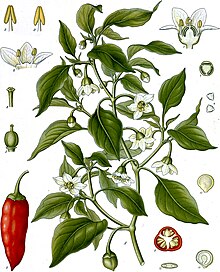Cayenne pepper
| Cayenne pepper | |
|---|---|
 |
|
| Genus | Capsicum |
| Species | C. annuum |
| Cultivar | Cayenne |
| Heat |
|
| Scoville scale | 30,000–50,000 SHU |
The cayenne pepper, also known as the Guinea spice,cow-horn pepper, red hot chili pepper, aleva, bird pepper,' or, especially in its powdered form, red pepper, is a cultivar of Capsicum annuum, which is related to bell peppers, jalapeños, paprika, and others. The Capsicum genus is in the nightshade family (Solanaceae). It is a hot chili pepper used to flavor dishes and named for the city of Cayenne, the capital of French Guiana.
The fruits are generally dried and ground, or pulped and baked into cakes, which are then ground and sifted to make the powdered spice of the same name.
Cayenne is used in cooking spicy dishes, as a powder or in its whole form (such as in Korean, Sichuan, and other Asian cuisine), or in a thin, vinegar-based sauce. It is generally rated at 30,000 to 50,000 Scoville units. It is also used as an herbal supplement, and was mentioned by Nicholas Culpeper in his Complete Herbal, 1653, as "guinea pepper", a misnomer for "guiana pepper".
Most cultivated varieties of cayenne, Capsicum annuum, can be grown in a variety of locations including tropical and temperate zones and need around 100 days to mature. Peppers prefer warm, moist, nutrient-rich soil in a warm climate. The plants grow to about 0.5–1 m (20–39 in) in height and should be spaced 1 m (3 ft) apart. In gardens, the plants may be planted as close as 30 cm (1 ft) apart in a raised bed, or simply grown in large pots. This may reduce the yield of an individual plant, but will increase yields per unit area.
...
Wikipedia
